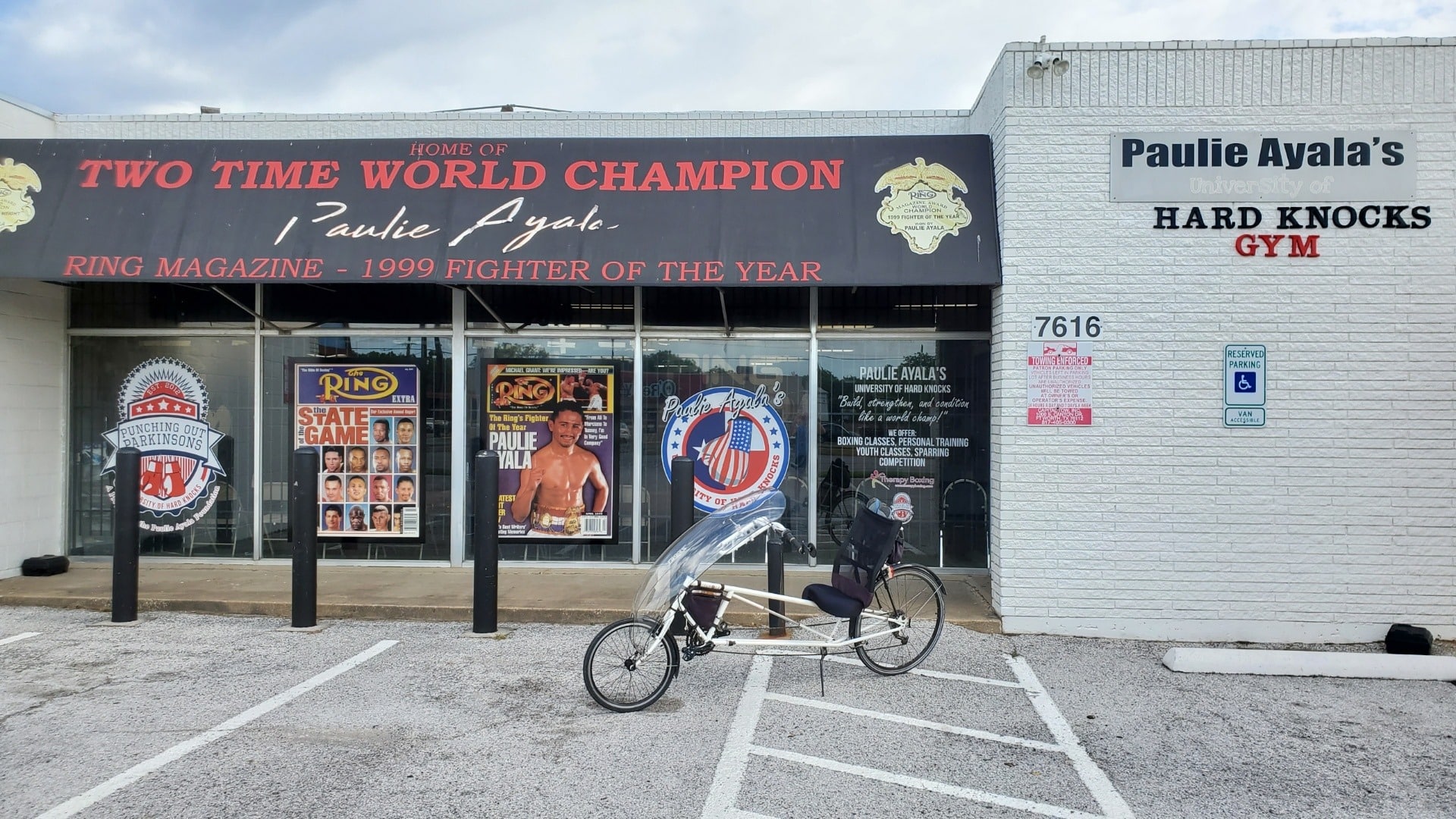The association between boxing and Parkinson's Syndrome is usually negative, but former world bantamweight weight champion Paulie Ayala is changing that perception. In a gym decorated with boxing posters featuring the most elite athletes in the world, men and women in their middle ages up to septuagenarians train as diligently as the champions looking over them from the walls.
Ayala’s gym hosts and helps to develop a boxing program that helps Parkinson’s sufferers battle the physical and mental deterioration associated with the as of yet incurable disease.

‘Punching Out Parkinson’s’ classes, run out of the University of Hard Knocks Gym in Fort Worth, has made a positive difference in people’s lives since 2011. Despite limitations set by the 2020 COVID outbreak, Ayala sees demand for the program getting bigger. Free classes (some insurance providers, local businesses and an annual charity drive help offset costs) started with five participants but has expanded to ten classes a week as word spread in the community with enrollment increasing more than tenfold. A majority of students attend twice a week for sessions that last between 75 to 90 minutes.
The Opponent
Parkinson’s Syndrome is a brain disorder, it attacks the central nervous system affecting movement and cognitive abilities. The most noticeable form the disease takes are tremors which hinder motor skills (caused by nerve cell damage in the brain when dopamine levels drop) in the hand, arms, and legs.
Often the first sign of Parkinson's is a slight quiver in one hand, followed by slowing movement, muscle rigidity, and loss of balance. Nearly one million people in American live with the disease, 60,000 Americans and luminaries like Michael J. Fox, Ozzy Osbourne, or Pope John Paul II are diagnosed every year. Only 4 percent of people with Parkinson’s will be diagnosed before their 50th birthday, and men are almost two times as likely to get the disease as women.
Ayala knew of the disease because of Muhammad Ali and Freddy Roach’s well-documented travails, but was made aware of his ability to help by happenstance. “I was in the gym one day and had a lady come in and tell me about a study being done in Indiana on a Parkinson’s class that trained with boxing.
She asked me if I would be interested in starting a class in Fort Worth, and I was excited to know that I could do something with people in my community. I have seen firsthand that if you train and exercise you can delay some of the effects.”
The Process
It is not a matter of just showing up for classes. Firmly regulated workouts are supervised by Ayala and a small staff who incorporate methods laid out by Elizabeth Zauber, MD, an associate professor of clinical neurology at Indiana University School of Medicine.
She advises Ayala on how to structure exercises and gives general outlines for levels of progression.
Initially, a participant is assessed through Ayala’s observations of their overall fitness level, then Doctor Zauber’s tests measure abilities of balance, gait, grip strength, age, or cognitive issues. Ayala added, “everyone who comes to my classes must get an approval by their doctor or neurologist, to show they can handle the physical aspects.”
Once a participant has been approved, the real work begins. Ayala, The Ring magazine Fighter of the Year in 1999, is a firm but understanding taskmaster. “When I get that in writing that they are OK, I don’t make any concessions in their training.
I train them like they are going to be a world champion. Because of the opponent they have, they are the underdogs. They are expected to lose this fight. I take it personally because they came to ask me for my help.” Non-contact boxing techniques are tailored to meet specific needs, such as hand-eye coordination, balance, or flexibility. Every month participants are reevaluated to measure improvements or set new goals.
Measuring Success
Ayala has other ways of measuring success as well, “One of the main benefits is the reduction of medication is what I have seen. But most of all it is the increase in confidence. They come in with the perception that maybe they can’t perform these exercises or drills. As they change their thinking not only do they perform them but do them well.”
Students graduate from basic exercises like lunges, stair steppers, sit-ups, push-ups, to punching routines with hand weights and jumping rope. Next hands get wrapped and gloves put on to hit cobra bags, speed bags, and even heavy bags.
All participants step into the ring. Once in the squared circle, they learn movements to cut off the ring while striking out at punch mitts held by some of Ayala’s amateur boxing stars. This is especially important, as it focuses a student’s energies on maintaining upper and lower body balance concurrently.

Jabs and hooks, to the body and head, and combinations are taught and called out just as they would be to any other boxer who trains at the gym. The punch numbering and calls help with some participants suffering cognitive declines. “We try to work on fast-twitch muscle fibers, reflexes, and a lot of cognitive exercise with hand pads.” Shouted instructions and punch counting work well on soft-voice disorders that are common in people with Parkinson's. Translating numbers to punches makes the workout mental as well as physical.
The Science & Results
The theory behind ‘Punching Out Parkinson’s’ is backed by clinical evidence. A limited case series conducted by the University of Indianapolis, and published in American Physical Therapy Association, showed short-term and long-term improvements in balance, gait, activities of daily living, and quality of life after the boxing training program.
None of this comes as a surprise to Ayala, who has been helped by the program in other ways. “It was seven years after I had retired, and was at a point in my life where I was asking God where I needed to be?
I prayed to God to send me fighters. Shortly, I realized that I didn’t just want fighters I wanted champions. These people that are in this program are champions. They are people that come and give you 100%. Whenever I see a person run down our 140-yard hall we have, money can’t pay for a feeling like that. To know that what you do has an impact on somebody else's life.”
If you would like to learn more about this fantastic program, please take the time to visit their website, Punching Out Parkinson’s. If you are in the area and want to drop in you can find them at:
